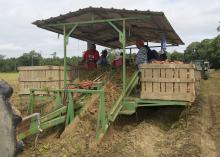Information Possibly Outdated
The information presented on this page was originally released on October 12, 2018. It may not be outdated, but please search our site for more current information. If you plan to quote or reference this information in a publication, please check with the Extension specialist or author before proceeding.
Sweet potato harvests progress, yields ‘fair’
PONTOTOC, Miss. -- Mississippi sweet potato fields that missed needed rains in June and July are experiencing favorable harvest conditions in October.
Jamie Earp, president of the Mississippi Sweet Potato Council, said yields are “fair, at best” at the halfway point in the 2018 harvest season.
“We just didn’t get any rains when we needed them this summer,” he said. “After North Carolina was hit by a hurricane, we thought it would help our prices more than it has.”
While fresh sweet potato prices have benefitted some from Hurricane Florence, Earp said processing-grade potatoes are not doing very well because of a supply surplus.
“Many of the processing-grade potatoes are not being removed from the fields and are going to waste,” he said.
Stephen Meyers, sweet potato specialist with the Mississippi State University Extension Service, said prices and yields can be difficult to pin down.
“Hurricane Florence made landfall in the Carolinas at the beginning of the harvest season. Since North Carolina is the national leader in sweet potato production, much of what happens there impacts prices across the rest of the Southeast,” Meyers said. “We don’t fully know the extent of their in-field losses or the effect flooding rains will have on the crop postharvest, but if the national supply is decreased and consumer demand remains constant, hopefully the unit price will tick upward.”
Meyers said Mississippi producers planted about 25,000 acres, a slight decrease from the 28,100 acres planted in 2017.
“The decrease in acreage was in large part due to the slow movement and low price of the 2017 crop,” he said.
Meyers said sweet potato transplanting operations, which began in May, tended to be ahead of historical norms. However, various fields transplanted in early June experienced poor plant stands or delayed development from heat stress.
“The Guava root-knot nematode is an emerging pest that has been present in North Carolina sweet potatoes for the last several seasons,” Meyers said. “Mississippi growers who import certified sweet potato seed roots from North Carolina are concerned and asking officials with the Mississippi Department of Agriculture and Commerce to consider regulations to protect our crop.”
Efforts to reduce the state’s dependence on certified seed from other states are underway at the Pontotoc Ridge-Flatwoods Branch Experiment Station.
Meyers said the Mississippi Agricultural and Forestry Experiment Station has developed a three-year transition plan for the Foundation Sweet Potato Program to increase availability of foundational material, reduce dependence on interstate transport of certified seed, mitigate risk and increase varietal selection.




